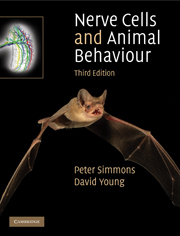Book contents
- Frontmatter
- Contents
- Preface
- 1 Organisation of animal behaviour and of brains: feeding in star-nosed moles and courtship in fruit flies
- 2 Signals in nerve cells: reflexes in mammals and insects
- 3 Neuronal mechanisms for releasing behaviour: predator and prey – toad and cockroach
- 4 Neuronal pathways for behaviour: startle behaviours and giant neurons in crayfish and fish
- 5 Eyes and vision: sensory filtering and course control in insects
- 6 Sensory maps: hunting by owls and bats
- 7 Programmes for movement: how nervous systems generate and control rhythmic movements
- 8 Changes in nerve cells and behaviour: learning in bees and rats; swarming in locusts
- 9 Nerve cells and animal signalling: songs of crickets, electric fish and birds
- References
- Index
- References
7 - Programmes for movement: how nervous systems generate and control rhythmic movements
Published online by Cambridge University Press: 05 August 2012
- Frontmatter
- Contents
- Preface
- 1 Organisation of animal behaviour and of brains: feeding in star-nosed moles and courtship in fruit flies
- 2 Signals in nerve cells: reflexes in mammals and insects
- 3 Neuronal mechanisms for releasing behaviour: predator and prey – toad and cockroach
- 4 Neuronal pathways for behaviour: startle behaviours and giant neurons in crayfish and fish
- 5 Eyes and vision: sensory filtering and course control in insects
- 6 Sensory maps: hunting by owls and bats
- 7 Programmes for movement: how nervous systems generate and control rhythmic movements
- 8 Changes in nerve cells and behaviour: learning in bees and rats; swarming in locusts
- 9 Nerve cells and animal signalling: songs of crickets, electric fish and birds
- References
- Index
- References
Summary
Sequences of muscle activity in locomotion are basic building blocks for much of an animal's behavioural repertoire, so understanding the mechanisms which generate and control them is fundamental to a knowledge of the neuronal control of behaviour. Many movements used for locomotion are rhythmically repeating, and there are three basic questions about the control of movements such as walking, flying or swimming. First, what mechanisms ensure that muscles contract in the appropriate sequence? In walking, for example, the basic pattern is repeated flexion and then extension of each leg, with flexion of the left leg coinciding with extension of the right. Second, how does a nervous system select, start and end a particular type of movement? For example, what initiates the pattern of walking; and how is walking rather than running or swimming selected? Third, how is the basic pattern for movement modulated appropriately? Stride pattern changes, for example, when a person walks up a flight of steps or turns a corner.
Experimental approaches to these questions have often involved work on lower vertebrates and invertebrates, animals in which the parts of the nervous system that generate programmes for movement contain a limited number of neurons. This offers the opportunity to identify and characterise the individual components involved in generating a particular movement. A question that has occupied many investigators, and the one on which this chapter focuses, is to determine the source of the repetition that underlies rhythmic movements.
Information
- Type
- Chapter
- Information
- Nerve Cells and Animal Behaviour , pp. 160 - 192Publisher: Cambridge University PressPrint publication year: 2010
